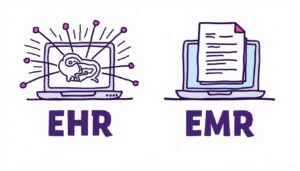Understanding Remote Working Security Risks: Cybersecurity 101 for Virtual Assistants
13 Aug 2024 By: Maria Rush
Updated
Work has changed drastically, with remote work now more common than ever. This shift brings new remote working security risks for virtual assistants and their work devices. This article explores the rise of remote work, the risks virtual assistants face, and essential cybersecurity practices to secure remote environments.

The Rise of Remote Work and Cybersecurity Challenges
Remote work involves working outside a traditional office, often from home. This trend is growing due to tech advancements and cultural shifts. However, it brings new remote working security risks.
As remote work grows, companies adapt to this change. They use secure VPNs and regular cybersecurity training to protect data and address remote working security risks. To further reduce exposure, organizations are turning to EDR solutions that monitor, detect, and respond to threats on remote devices.
Defining Remote Work
Remote work covers many occupations and industries performed outside a central office. Virtual assistants, in particular, provide administrative, technical, or creative help remotely to clients or companies.
With advanced communication tools and project management software, virtual assistants have become essential to many businesses. This shift toward a distributed workforce has reshaped traditional work structures and introduced new remote working security risks, paving the way for a more interconnected global economy.
The Cybersecurity Landscape in Remote Work
Ensuring cybersecurity in remote work environments is challenging. Remote settings lack the physical security of traditional offices. Personal devices and home networks create new remote working security risks.
Companies invest in strong cybersecurity measures like multi-factor authentication and encryption. These steps protect data transmitted between remote workers and corporate servers. By staying vigilant, organizations can reduce threats and keep data secure in remote work environments.
Managing Remote IT Infrastructure: A Comparative Look
Securing remote work environments has pushed many businesses, especially in BPO, to use virtual desktop solutions. Azure Virtual Desktop and Amazon Workspaces Web are two options tailored to different needs.
- Azure Virtual Desktop provides a full desktop experience, perfect for businesses with varied software needs.
- Amazon Workspaces Web offers a secure browser environment, ideal for companies using web-based apps, and comes at a lower cost.
Both platforms help businesses maintain security and compliance while managing remote IT infrastructure challenges.
Why Virtual Assistants are Vulnerable
Virtual assistants face heightened remote working security risks due to the nature of their work. Virtual administrative assistants, in particular, are responsible for handling sensitive data like client information, financial records, and intellectual property. Working with multiple clients increases their exposure to cyber threats.
To combat these vulnerabilities, Virtual assistants should stay informed about the latest cybersecurity practices, including using a password manager to securely store and manage their credentials. Regular software updates, secure communication channels, and data encryption can strengthen their security and protect both client information and their professional reputation.
Trending Now
Cybersecurity threats surged in 2023, with over 3,200 U.S. data breaches, up from 1,800 in 2022, impacting employees who use home wi-fi. Human error, advanced cybercriminals, and vendor vulnerabilities drove this increase. Cloud technology was involved in 82% of breaches due to configuration errors and unsecured backups. Ransomware attacks intensified, with hackers threatening to expose stolen data. These breaches cost U.S. companies an average of $9.44 million in 2022. While remote work raises concerns, remote workers are often more vigilant about cybersecurity. Strong measures like employee training, multi-factor authentication, VPNs, and regular updates are crucial for both remote and in-office settings.
Understanding the Nature of Cybersecurity Threats
Before discussing cybersecurity measures, it’s important to understand the threats virtual assistants face in remote work environments. These threats include:
- Social Engineering: Manipulates individuals to gain unauthorized access to sensitive information, often through psychological tricks or exploiting human vulnerabilities.
- Malware: Malicious software designed to infiltrate and damage systems, including viruses, worms, trojans, and spyware.
- Phishing: Tactics that trick individuals into revealing sensitive information, like passwords or financial details, by posing as a trusted entity.
- Ransomware: A type of malware that encrypts files and demands a ransom for their release.
Common Types of Cyber Threats
Cyber threats constantly evolve, so virtual assistants must stay updated on the latest hacker techniques. Beyond the common threats, they should also be aware of:
- Cross-Site Scripting (XSS): Attackers inject malicious code into a website to steal sensitive data or perform unauthorized actions.
- Distributed Denial-of-Service (DDoS) Attacks: Excessive traffic overwhelms a website or network, making it inaccessible to legitimate users.
- SQL Injection: Attackers exploit database vulnerabilities to gain unauthorized access or manipulate data. Data extraction methods like sql to csv exports require careful security considerations, as improperly configured database access can create additional vulnerabilities that attackers might exploit to extract sensitive information from corporate databases.
Identifying Potential Risks in Remote Work
Remote work brings specific risks that virtual assistants must watch for, including:
- Data Breaches: Increasing data breaches highlight the need to protect client and personal information.
- Unsecured Wi-Fi Networks: Public Wi-Fi is vulnerable to interception and unauthorized access.
- Insecure Devices: Outdated systems and unpatched software create exploitable vulnerabilities.
- Lack of Physical Security: Remote environments lack physical security, making sensitive data easier to steal.
Specific Threats to Virtual Assistants
Virtual assistants face unique threats due to the sensitive data they manage. They often access client information, financial records, and intellectual property, making them prime targets for hackers. Virtual assistants may also download malicious software or fall for phishing scams when interacting with clients or third-party platforms. Sing tools like a domain analyzer can help spot suspicious domains or misconfigured records, reducing the risk of email-based threats. This makes strong cybersecurity essential. They should use strong passwords, update software regularly, and stay alert to suspicious emails or messages.
Essential Cybersecurity Measures for Remote Work
To reduce cybersecurity risks in remote work, virtual assistants should secure their work environments. Here are key measures:
Importance of Strong Passwords and Two-Factor Authentication
Using strong, unique passwords and enabling two-factor authentication adds vital security. Virtual assistants should avoid simple, guessable passwords and activate two-factor authentication to protect sensitive data.
For strong passwords, use a mix of letters, numbers, and special characters. You can also consider adding invisible characters within the password. These are Unicode characters that appear unseen to humans, but online platforms can read them. Avoid personal information like birthdays or names, as hackers can easily guess these. Regularly update passwords and avoid reusing them across multiple accounts for better security.
The Role of VPNs in Secure Remote Work
A Virtual Private Network (VPN) secures the connection between a virtual assistant’s device and the internet. It encrypts data, making browsing safer. Virtual assistants should use VPNs when working remotely, especially on public Wi-Fi or when accessing sensitive information.
VPNs come in free and paid versions with different encryption levels. Choose a reputable VPN provider that values privacy and security. Always keep the VPN software updated to fix security vulnerabilities. For deals on VPNs, antivirus, and other privacy tools, you can explore offers listed on ProxyCoupons.
Secure Communication Channels for Virtual Assistants
Virtual assistants communicate with clients using email, messaging apps, and video tools while ensuring secure connections on home wi-fi. It’s vital to use encrypted channels to protect conversations and file transfers. In addition to secure communication apps, using reliable proxy services like Proxyshop can help mask your IP address and add another layer of privacy to your online activity.
End-to-end encryption ensures only the sender and recipient can access content. Apps like Signal and WhatsApp offer this security. Virtual assistants should also beware of phishing attempts and suspicious links that could compromise their communications.
Implementing Cybersecurity Best Practices for Virtual Assistants
In addition to essential cybersecurity measures, virtual assistants should follow best practices to maintain a secure remote work environment, protecting both their data and their clients’ sensitive information.
Regular Software and System Updates
Regularly updating software and systems is crucial. Enabling automatic updates and frequently checking for new ones reduces the risk of breaches by staying current with security patches.
Safe Internet Browsing
Safe internet browsing is also vital. Virtual assistants should avoid suspicious emails and links to prevent phishing attacks or harmful downloads. Steering clear of untrustworthy websites and not clicking on unfamiliar pop-up ads can reduce the risk of encountering malicious content.
Data Backup and Recovery Strategies
Prevention isn’t enough; robust data backup and recovery strategies are necessary. Regularly backing up important files ensures that essential information can be recovered after a cyber attack or system failure. Secure cloud storage or external hard drives provide extra protection for data backups. Utilizing third-party cloud backups adds an additional layer of security and ensures data availability even in cases of local hardware failures.
Continuous Learning and Adaptation
Staying updated on the latest cybersecurity trends is important. Continuous learning helps virtual assistants adapt to new threats and implement proactive security measures.
Conclusion
Understanding remote work’s unique risks and applying key cybersecurity practices can protect virtual assistants and their clients from threats. Prioritizing cybersecurity is essential for a secure and successful remote work environment.
As you embrace remote work and prioritize cybersecurity, consider enhancing your operations with a reliable virtual assistant or customer service team. HelpSquad BPO offers exceptional outsourcing services, ensuring secure and efficient handling of back-office tasks, customer support, and research. Our bilingual agents are available 24/7, starting at just $8.50 per hour. Ready to boost security and productivity in your remote work environment? Start your trial with HelpSquad BPO today and experience the difference professional assistance can make.


